Lexington, Kentucky 作者: 来源: 发布时间:2021-11-05
I.Population and Area
₋Area
Land: 284.5 sq mi (736.9 km2)
₋Population
Total: 323,152
Density: 1,042.8/sq mi (364.5/km2)
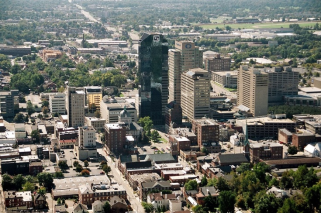
II.Natural Geography
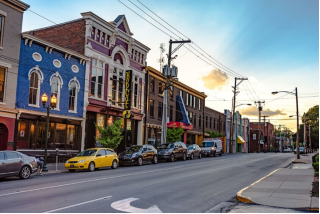
City Overview
₋Lexington is the second-largest city in Kentucky and the 60th-largest city in the United States. Known as the "Horse Capital of the World," it is the heart of the state's Bluegrass region. Notable locations in the city include the Kentucky Horse Park, The Red Mile and Keeneland race courses, Rupp Arena, Transylva nia University, the University of Kentucky, and Bluegrass Community and Technical College. Lexington ranks 10th among US cities in college education rate, with 39.5% of residents having at least a bachelor's degree.
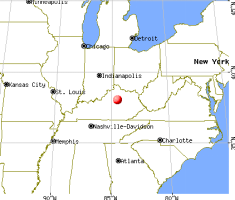
₋In the 2019 U.S. Census Estimate, the city's population was 323,152 anchoring a metropolitan area of 517,056 people and a combined statistical area of 745,033 people. By land area, Lexington is the 28th largest city in the United States. The city is consolidated entirely within Fayette County, and vice versa. It has a nonpartisan mayor-council form of government, with 12 council districts and three members elected at large, with the highest vote-getter designated vice mayor.
III.ECONOMY
₋The average salary in Lexington, KY is $57k. Trends in wages decreased by -2.3 percent in Q1 2020. The cost of living in Lexington, KY is 4 percent higher than the national average. The most popular occupations in Lexington, KY are Operations Manager, Project Manager, (Unspecified Type / General), and Mechanical Engineer which pay between $35k and $103k per year. The most popular employers in Lexington, KY are University of Kentucky (UK), Lockheed Martin Corp, and Lexmark.
₋Website: https://www.payscale.com/research/US/Location=Lexington-KY/Salary
IV.Industrial Characteristics
₋Lexington has one of the nation's most stable economies. Lexington describes itself as having "a fortified economy, strong in manufacturing, technology, and entrepreneurial support, benefiting from a diverse, balanced business base".The Lexington Metro Area had an unemployment rate of 3.7% in August 2015, lower than many cities of similar size. In 2011 Lexington was ranked as the 4th-best city for "Businesses and Careers" by Forbes magazine, the 5th-best city for Young Professionals in 2008, and 6th-Best "Value Cities" in 2011 by Kiplinger.
₋The city is home to several large corporations. Sizable employment is generated by four Fortune 500 companies: Xerox (which acquired Affiliated Computer Services), Lexmark International, Lockheed-Martin, and IBM, employing 3,000, 2,800, 1,705, and 552, respectively. United Parcel Service, Trane, and Amazon.com, Inc. have large operations in the city, and Toyota Motor Manufacturing Kentucky is within the Lexington CSA, located in adjoining Georgetown. A Jif peanut butter plant located here produces more peanut butter than any other factory in the world.
₋Notable corporate headquarters include: Lexmark International, a manufacturer of printers and enterprise software; Link-Belt Construction Equipment, a designer and manufacturer of telescopic and lattice boom cranes; Big Ass Fans, a manufacturer of large ceiling fans and lighting fixtures for industrial, commercial, agricultural, and residential use; A&W Restaurants, a restaurant chain known for root beer; Fazoli's, a fast-food Italian-style chain that has expanded to more than 20 states; Tempur Sealy International, a manufacturer of mattresses; Florida Tile, a manufacturer of porcelain and ceramic tile; and the Forcht Group of Kentucky, a holding company that employs more than 2,100 people across Kentucky. Forcht Group operates several businesses in Lexington, including First Corbin Bancorp, Kentucky National Insurance Company, My Favorite Things, BSC, a bank data-services company; and First Lab, among others.
₋The city's largest employer, the University of Kentucky, as of 2017, employed 13,563. The university ranks as the 9th-largest economic company in the state of Kentucky, with an annual budget of $1.4 billion, and the College of Medicine within the university is the 21st-largest company in the state.
₋Other sizable employers include the Lexington-Fayette County government and other hospital facilities. The Fayette County Public Schools employ 5,374, and the Lexington-Fayette Urban County Government employs 2,699. Central Baptist Hospital, Saint Joseph Hospital, Saint Joseph East, and the Veterans Administration Hospital employ 7,000 persons in total.
V.Attractions
1.Kentucky Horse Park
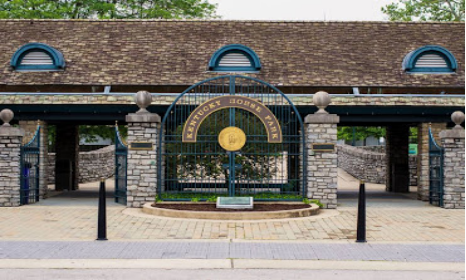
₋Kentucky Horse Park is a working horse farm, international equestrian competition venue, and an educational theme park opened in 1978 in Lexington, Kentucky. It is located off Kentucky State Highway 1973 (Iron Works Pike) and Interstate 75, at Exit 120, in northern Fayette County in the United States. The equestrian facility is a 1,224-acre (4.95 km2) park dedicated to "man's relationship with the horse." Open to the public, the park has a twice daily Horses of the World Show, showcasing both common and rare horses from around the globe. The horses are ridden in authentic costume. Each year the park is host to a number of special events and horse shows.
₋Additionally, the park contains the International Museum of the Horse, a Smithsonian Affiliate, which has a permanent collection of horse history and memorabilia, along with a rotating historical collection focused on a particular theme. Past themes include A Gift from the Desert (Arabia), Imperial China, and All the Queen's Horses (Britain).
₋Beginning with the 1979 arrival of Forego, one of the leading handicap horses of the 1970s, the Kentucky Horse Park has been home to some of the world's greatest competition horses, including John Henry, Horse of the Decade for the 1980s and the top money-winning Thoroughbred gelding in racing history. With the exception of a few months in 1986, John Henry lived at the park from 1985 until his death in 2007, alongside other racing greats such as Forego and his fellow 1970s champion Bold Forbes, and more recent residents Cigar, voted Horse of the Decade for the 1990s, and Da Hoss, the first horse to win Breeders' Cup races in non-consecutive years. In late 2008, the champions Alysheba and Funny Cide became residents, but Alysheba died at the park in March 2009. 1994 Kentucky Derby winner, Go For Gin, became a resident of the barn in 2011, while Cigar died at the park in 2014.
₋Besides Thoroughbred horses, Standardbred pacing greats such as Staying Together and Western Dreamer, Cam Fella (deceased) and Rambling Willie (deceased), and Standardbred trotting champion Mr. Muscleman have made the Kentucky Horse Park their home, as well as 5-gaited American Saddlebred geldings CH Gypsy Supreme, CH Imperator and CH Sky Watch (all deceased).
₋Address: 4089 Iron Works Pkwy, Lexington, KY 40511, United States
₋Website: https://kyhorsepark.com/
2.Waveland State Historic Site
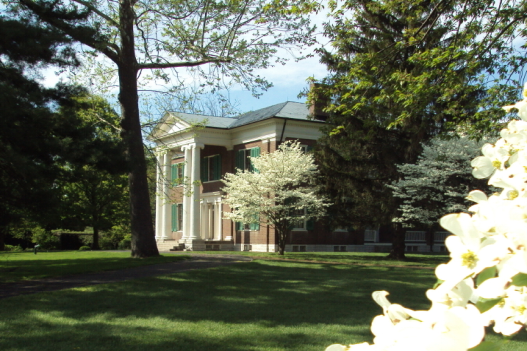
Waveland State Historic Site, also known as the Joseph Bryan House, in Lexington, Kentucky is the site of a Greek Revival home and plantation now maintained and operated as part of the Kentucky state park system. It was the home of the Joseph Bryan family, who followed Daniel Boone through the Cumberland Gap, and became an early settler and horseman of this region.
The history of Waveland begins with the Boone and Bryan families. The two families met in the Yadkin River Valley, North Carolina, when the Boones moved onto the land next to the Bryan family. It was said that the Bryans outfitted several of the Boones hunting trips. Eventually William Bryan married Daniel Boone's sister, Mary Boone. William and Mary had a son, Daniel Boone Bryan. Daniel Boone surveyed the land that he would give to his nephew, Daniel Boone Bryan, who was a renowned historian, frontiersman, and poet. The area surveyed was about 2,000 acres (810 ha) about six miles from present-day downtown Lexington, Kentucky.
Daniel Boone Bryan
Daniel Boone Bryan settled the land around Waveland by 1786. The name Waveland came from the waves that were visible when the wind blew the fields of grain and hemp surrounding the house. The area was once the home of the biggest hemp and rope producers of the nation. When Daniel Boone Bryan moved to what is now Waveland, he built a small stone cabin. The Waveland mansion was constructed between the fall of 1844 and late 1848. Joseph Bryan had the house built "to please his father" according to a letter written by his son Elijah in 1845. Bryan constructed his office with seven doors, each for a different part of his life. There was a door that connected to the formal dining room, where he and guests would eat. Another door, which locked from his office, was to two upstairs rooms where he would allow travelers to stay if they paid him. He made sure he was able to lock them in for safety reasons. The travelers could not leave their room unless Joseph unlocked the door, meaning he was safe from being robbed or attacked by them at night. Another door led to the fields where the slaves worked. This meant easier communication with them when necessary. Another door led out to the road where businessmen would often travel in to see him. Being an important and successful businessman in Kentucky, he often was visited by others. One door lead into the family parlor, where he could be with his children. The remaining two doors were closets, which were used as safes.
Bryan was at once a gunsmith, having a large shop and employing twenty five men at one time; manufacturer of saltpeter and gunpowder; operator of a gristmill, a blacksmith shop, Baptist church, a female seminary, a distillery and a paper mill. He was able to manage all of these successfully. He and his wife Elizabeth had twelve children.
Joseph Bryan
₋Bryan's son, Joseph, inherited Waveland and made the most memorable piece of this historic site. Joseph Bryan's wife convinced him to construct a more memorable and beautiful home than his father had built. He tore down the old stone cabin two years after his father's death so that he could build the large, opulent house that his wife wanted. To reduce construction costs, Bryan constructed the stairway rail using flat pieces of wood instead of rounded ones. Although his wife wanted expensive marble baseboards, Bryan used cheaper stones and had them painted to look like marble.
₋Proof of how successful the Bryans' businesses were was that he was able to construct most of the house using only his businesses and materials on his land; the lumber he used came from Waveland plantations, the wrought iron was made at the Waveland blacksmith, the bricks used in the buildings were made from some clay gathered on the land, which was then burned on site. The resources that were not at Waveland were the stones that were used for the foundation of the house and also for some decorative work. The stones that were needed were quarried and dressed at Tyrone on the Kentucky River and moved to Waveland.
₋Bryan decided to build a classic Greek Revival structure. Inspired by the work of Lexington architect John McMurtry, Bryan hired Washington Allen, a well-known Lexington contractor, to oversee the construction of his new home. The house contained fourteen high ceiling rooms, which made them each cooler in the summer, as heat rises. The main doorway of the mansion is considered to be an exact replica of the doorway of the north entrance to the Erechtheion at the Acropolis in Athens. The house also contains a porch on either side, to give a view of the beautiful surrounding country side, as well as a spacious hall and a portico.
₋Throughout their time at Waveland, the Bryans kept slaves. There were thirteen slaves, three women and ten men. The women were to keep the house clean as well as do the cooking. Margaret Cartmell Bryan, Joseph's wife, made all of the clothing for all of the slaves and the Bryan family. The invention of the sewing machine significantly reduced the time it took her to make clothing.
₋The male slaves were in charge of the farm. Each one had to keep 20 acres (8.1 ha) of land. In order to save time traveling, the Bryans allowed the slaves to build houses on the property they kept. The slaves at Waveland enjoyed freedoms that were uncommon for other slaves of the day. When they were not working, they were allowed to hunt for themselves. They were also allowed to buy and sell at the local markets, keeping any profits for themselves. Joseph Bryan also allowed the slaves to keep weapons. The slave quarters were two bricks thick, making them better insulated than many other homes in Kentucky.
₋Joseph Bryan supported the Confederacy during the Civil War and gave them supplies such as horses and food produced on his land. When Union authorities discovered this, they sought to arrest him. Bryan fled to Canada, returning years later when the war had ended. As a result of the war, the slaves at Waveland were emancipated, but they chose to stay and continue working for Bryan, who paid them for their labor, but charged them rent.
₋Joseph Henry Bryan
₋Joseph Henry Bryan, one of Bryan's eleven children, lost his house, so he and his wife and children moved back into Waveland with his father. Eventually, Joseph Bryan, Sr. moved out, leaving Joseph Henry Bryan as the owner of Waveland. While he owned Waveland, he established it as one of the premier thoroughbred and trotter farms in Kentucky. Waveland produced some great horses such as "Waveland Chief", "Ben-Hur", "Eric", "Olaf" and "Wild Rake", who never lost a heat and was sold to William Rockefeller for $7800 in the 1880s. Joseph Henry Bryan also built a race track across from the mansion. He and other businessmen would go out to watch horse races. The women, who were not allowed to go, would often go up to the top floor of the house and watch the races with their binoculars.
₋Joseph Henry Bryan was a notorious gambler. In less than seven years, he lost over one million dollars. Another family member had to sell their home so that they could try to keep Joseph Henry Bryan from losing the property. Eventually, however, Bryan was unable to pay his debt. For this, he was never forgiven by his family. He had to sell the house at auction just to try to pay off the debt. Salle A. Scott bought Waveland in 1894. She sold the property in 1899 to James A Hullet. In 1956, the Commonwealth of Kentucky bought the house and less than 200 acres (81 ha) of the original 2,000 acres (810 ha) for use by the University of Kentucky as experimental farmland.
₋Museum
₋In 1957, Waveland became a museum that depicted Kentucky life from pioneer days to the Civil War. The house sits on 10 acres of land and now depicts life on a plantation during the 1840s. Period-appropriate furniture was donated to the site. Many of the buildings did not survive, but Waveland currently contains the mansion, decorated in Antebellum style, and four outbuildings, which are the ice house, a two-story brick building that was the slave quarters, a barn, and a smokehouse.
₋Tours are given daily for much of the year, and the tour guides dress in the style of the 1840s. Tours include the historic house, the slave quarters, smokehouse and ice house, and focus on the Bryan family and life on a 19th-century Kentucky plantation.
lAddress: 225 Waveland Museum Ln, Lexington, KY 40514, United States
₋Opened: 1845
₋Phone: +1 859-272-3611
₋Website: https://parks.ky.gov/lexington/parks/historic/waveland-state-historic-site
3.The Arboretum, State Botanical Garden of KY
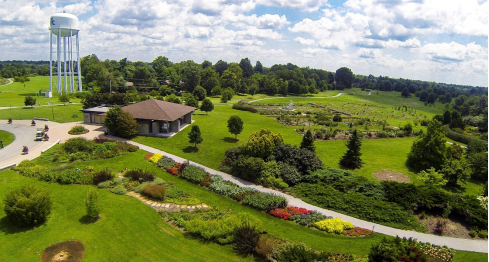
₋The Arboretum, State Botanical Garden of Kentucky (Also known as University of Kentucky Arboretum or Lexington Arboretum), 40 hectares or 100 acres (0.40 km2), is located at the University of Kentucky in Lexington, Kentucky, United States. It is open to the public from dawn to dusk every day of the year.
₋It contains the Kentucky Children's Garden, a Home Demonstration Garden which includes a Vegetable Garden, Herb Garden, Home Fruit and Nuts Garden (including Black, Persian and Japanese Walnuts, Pecan, Shellbark and Shagbark Hickory, Chinese Chestnut as well as dwarf apple cultivars, an American Persimmon and native Pawpaw trees), the All America Selection Trials Garden, Perennial Collection, Ground Cover Demonstration, Woody Plant Collection, and a "Walk Across Kentucky" that simulates Kentucky's seven regional landscapes: Bluegrass, Knobs, Appalachian Plateaus, Cumberland Mountains, Mississippian Plateaus and Outer Nashville Basin (Pennyroyal), Shawnee Hills, Mississippi Embayment and Alluvial Basin (Jackson Purchase).
₋The Arboretum was created in 1991, at which time it was overrun with non-native invasive plants such as honeysuckle and wintercreeper. The removal of such invasive plants has been and continues to be a major goal of Arboretum staff and volunteers.
₋The Friends of the Arboretum is an organization that supports the arboretum. They offer many opportunities for volunteering at the arboretum. As of 2014 the Director of the arboretum, Molly Davis, has set many goals such as expansion of the visitors center and continue to fight against invasive plants. In order to do this the arboretum needs funding. While the government and personal donations are where the funding comes from now, the arboretum still needs more funding to expand on things such as a bigger victors center and an enhanced prairie area.
₋Since the arboretum has been in place, the town of Lexington has seen many changes to their environment. These changes are less runoffs from the rain. As well as less CO2 in the air. Both continue to decrease as the arboretum grows. Both are also good for the city as they are attempting to become a more green city.
₋Address: University of Kentucky, 500 Alumni Dr, Lexington, KY 40503, United States
₋Phone: +1 859-257-6955
VI.History
₋This area of fertile soil and abundant wildlife was long occupied by varying tribes of Native Americans. European explorers began to trade with them, but settlers did not come in large numbers until the late 18th century.
₋Lexington was named in June 1775, in what was then considered Fincastle County, Virginia, 17 years before Kentucky became a state. A party of frontiersmen, led by William McConnell, camped on the Middle Fork of Elkhorn Creek (now known as Town Branch and rerouted under Vine Street) at the site of the present-day McConnell Springs. Upon hearing of the colonists' victory in the Battles of Lexington and Concord on April 19, 1775, they named the site Lexington. It was the first of many American places to be named after the Massachusetts town. Danger from the ensuing war with the British and allied tribes delayed permanent settlement for four years.
₋In 1779, during the American Revolutionary War, Col. Robert Patterson and 25 companions came from Fort Harrod and erected a blockhouse. They built cabins and a stockade, establishing a settlement known as Lexington. In 1780, Lexington was made the seat of Virginia's newly organized Fayette County.
₋The town was chartered on May 6, 1782, by an act of the Virginia General Assembly. The First African Baptist Church was founded c. 1790 by Peter Durrett, a Baptist preacher and slave held by Joseph Craig. Durrett helped guide "The Travelling Church", a group migration of several hundred pioneers led by the preacher Lewis Craig and Captain William Ellis from Orange County, Virginia to Kentucky in 1781. It is the oldest black Baptist congregation in Kentucky and the third-oldest in the United States.
₋In 1806, Lexington was a rising city of the vast territory to the west of the Appalachian Mountains; poet Josiah Espy described it in a letter:
₋Lexington is the largest and most wealthy town in Kentucky, or indeed west of the Allegheny Mountains; the main street of Lexington has all the appearance of Market Street in Philadelphia on a busy day ... I would suppose it contains about five hundred dwelling houses [it was closer to three hundred], many of them elegant and three stories high. About thirty brick buildings were then raising, and I have little doubt but that in a few years it will rival, not only in wealth, but in population, the most populous inland town of the United States ... The country around Lexington for many miles in every direction, is equal in beauty and fertility to anything the imagination can paint and is already in a high state of cultivation.
₋Residents have fondly continued to refer to Lexington as "The Athens of the West" since Espy's poem dedicated to the city.
₋In the early 19th century, planter John Wesley Hunt became the first millionaire west of the Alleghenies. The growing town was devastated by a cholera epidemic in 1833, which had spread throughout the waterways of the Mississippi and Ohio valleys: 500 of 7,000 Lexington residents died within two months, including nearly one-third of the congregation of Christ Church Episcopal. London Ferrill, second preacher of First African Baptist, was one of three clergy who stayed in the city to serve the suffering victims. Additional cholera outbreaks occurred in 1848–49 and the early 1850s. Cholera was spread by people using contaminated water supplies, but its transmission was not understood in those years. Often, the wealthier people would flee town for outlying areas to try to avoid the spread of disease.
₋Planters held slaves for use as field hands, laborers, artisans, and domestic servants. In the city, slaves worked primarily as domestic servants and artisans, although they also worked with merchants, shippers, and in a wide variety of trades. Plantations raised commodity crops of tobacco and hemp, and thoroughbred horse breeding and racing became established in this part of the state. In 1850, one-fifth of the state's population were slaves, and Lexington had the highest concentration of slaves in the entire state. It also had a significant population of free blacks, who were usually of mixed race. By 1850, First African Baptist Church, led by London Ferrill, a free black from Virginia, had a congregation of 1,820 persons, the largest of any, black or white, in the entire state.
₋Many of 19th-century America's leading political and military figures spent part of their lives in the city, including U.S. President Abraham Lincoln and Confederate President Jefferson Davis (who attended Transylvania University in 1823 and 1824); Confederate general John Hunt Morgan; U.S. Senator and Vice President John C. Breckinridge; and Speaker of the House, U.S. Senator, and Secretary of State Henry Clay, who had a plantation nearby. Lincoln's wife Mary Todd Lincoln was born and raised in Lexington, and the couple visited the city several times after their marriage in 1842.
₋During the 19th century, migrants moved from central Kentucky to Tennessee and Missouri. They established their traditional crops and livestock in Middle Tennessee and an area of Missouri along the Missouri River. While Kentucky stayed in the Union during the American Civil War, the residents of different regions of the state had divided loyalties.
₋20th century to present
₋Amidst the tensions between black and white populations over the lack of affordable housing in the city, a race riot broke out on September 1, 1917. At the time, the Colored A.&M. Fair (one of the largest African American fairs in the South) on Georgetown Pike attracted more African Americans from the surrounding area into the city. Also during this time, some Kentucky National Guard troops were camping on the edge of the city. Three troops passed in front of an African American restaurant and shoved some people on the sidewalk. A fight broke out, reinforcements for the troops and civilians both appeared, and soon a riot had begun. The Kentucky National Guard was summoned, and once the riot had ended, armed soldiers on foot and mount and police patrolled the streets. All other National Guard troops were barred from the city streets until the fair ended.
₋On February 9, 1920, tensions flared up again over the trial of Will Lockett, a black serial killer who murdered 10-year-old white girl Geneva Hardman. When a large mob gathered outside the courthouse where Lockett's trial was underway, Kentucky Governor Edwin P. Morrow massed the National Guard troops into the streets and work alongside local law enforcement. As the mob advanced on the courthouse, the National Guard opened fire, killing six and wounding 50 others. Fearing further retaliation from the mob, Morrow urged the United States Army to provide assistance. Led by Brigadier General Francis C. Marshall, approximately 1,200 federal troops from nearby Camp Zachary Taylor moved into the city the same day to assist National Guard forces and local police in bringing order and peace. Marshall declared martial law in the city and had soldiers positioned throughout the area for two weeks. Lockett was eventually executed on March 11 at the Kentucky State Penitentiary in Eddyville after being found guilty of murdering Hardman.
₋In 1935 during the Great Depression, the Addiction Research Center (ARC) was created as a small research unit at the United States Public Health Service hospital in Lexington. Founded as one of the first drug rehabilitation clinics in the nation, the ARC was affiliated with a federal prison. Expanded as the first alcohol and drug rehabilitation hospital in the United States, it was known as "Narco" of Lexington. The hospital was later converted to operate as part of the federal prison system; it is known as the Federal Medical Center, Lexington and serves a variety of health needs for prisoners. Lexington also served as the headquarters for a pack horse library in the late 1930s and early 1940s.
₋Lexington has continued as the center of thoroughbred horse breeding and racing in Kentucky, with major racing and sales facilities, as well as a museum of horses and the sport.
VII.Other Information
₋Highways
₋The northeast border of Lexington has direct access to Interstate 64 and Interstate 75, but freeways do not run through downtown or other sections of the city. Instead, Lexington has two beltways: inner New Circle Road (KY 4) and outer Man o' War Boulevard (southern semicircle), then numerous arterial highways/U.S. routes radiate from downtown to the surrounding suburbs and small towns.
₋Lexington suffers considerable traffic congestion for a city of its size due to the lack of freeways, the proximity of the University of Kentucky to downtown, and the substantial number of commuters from outlying towns. For traffic relief on northern New Circle Road, Citation Boulevard is planned to connect Leestown Road and Russell Cave Road. Other proposed projects include widening/closing certain roads and changing directions from one-way to two-way.
₋Air
₋Blue Grass Airport is Lexington's primary commercial airport. It provides about 13 nonstop flights and a total of 86 flights daily from its two runways. Four major airlines operate connection service at Blue Grass, including Allegiant Air, American Eagle, Delta Air Lines, and United Express.
₋On August 27, 2006, Comair Flight 5191 took off from the wrong runway, and crashed in a nearby field, killing 49 of the 50 passengers, leaving the first officer alive but badly burned. The aircraft involved was a 50-seat Bombardier Canadair Regional Jet CRJ-100ER, serial number 7472. On August 27, 2011, a memorial sculpture depicting 49 steel birds flying was unveiled and dedicated to the victims.
₋The airport is located 4 mi (6 km) west of the city center, at the intersection of US 60 (Versailles Road) and Man o' War Boulevard.
₋In addition to commercial airline service, the airport is also home to several private (general aviation) operators, including TACAir, which serves as the airport's fixed-base operator. Flight training and aircraft maintenance services are also offered. A new general aviation runway was dedicated August 4, 2010.
₋Public transportation
₋Lexington is served by Lextran, a public transit bus agency operated by LFUCG and has been in existence since 1972. Lextran (officially the Transit Authority of the Lexington-Fayette Urban County Government) is a public transportation bus system serving Lexington, Kentucky. It runs bus routes throughout the city, which mostly all converge in downtown at the Lexington Transit Center located at 220 East Vine. It provides public transportation in the form of buses and lift vans. It operates seven days a week on a total of 24 bus routes from 5:00 am until 12:30 am. In addition to mainline and paratransit, Lextran contracts with the University of Kentucky and operates two routes around the campus. It also runs two routes to the Bluegrass Community and Technical College campuses. Though Lexington and Fayette County are a consolidated government, Lextran does not provide service outside the Lexington city proper due to limited funding.
₋Modal characteristics
₋In 2016, 78.5 percent of working Lexington residents commuted by driving alone, 8.5 percent carpooled, 2 percent used public transportation, and 4 percent walked. About 2.3 of commuters used all other forms of transportation, including taxi, bicycle, and motorcycle. About 4.7 worked out of the home.
₋In 2015, 7.2 percent of city of Lexington households were without a car, which increased slightly to 7.4 percent in 2016. The national average was 8.7 percent in 2016. Lexington averaged 1.7 cars per household in 2016, compared to a national average of 1.8 per household.
₋Transportation planning
₋The Lexington Area Metropolitan Planning Organization is responsible for transportation planning for Fayette and Jessamine Counties. This includes activities such as carpool matching, administering a commuter vanpool program, air quality forecasting, bicycle and pedestrian planning, congestion management, and developing transportation plans and documents.
VIII.Contact Information
Government
Type: Mayor–council
Mayor: Linda Gorton (D)
City Hall
Address: 200 E. Main St.Lexington, KY 40507
TEL: (859) 425-2255
Website: https://www.lexingtonky.gov/index.php/contact
